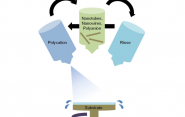
Remember all the high-tech transparent technology Tom Cruise used in Minority Report? Well, it’s been 13 years since that movie came out – where are our see-through devices?
It turns out that batteries are a big part of the holdup: typically, their materials are thick and optically absorbent. Creating an invisible battery has become a major challenge in the electronics industry, as demand increases for transparent phones, wearable electronics, sensors and screens.
The lab of André Taylor, associate professor of Chemical & Environmental Engineering, has made a big step toward this goal by developing a technique to make transparent electrodes for lithium-ion batteries. Their results are published online in the journal ACS Nano. Forrest Gittleson, post-doctoral associate at Yale in Chemical & Environmental Engineering, is the lead author.
With a technique known as spin-spray layer-by-layer (SSLbL) assembly, the researchers created ultrathin and transparent films from single-walled carbon nanotubes (SWNT) and vanadium pentoxide (V2O5) nanowires to serve as battery anodes and cathodes.
Control over deposition has long been an issue with films containing one-dimensional nanomaterials, said Taylor, the senior author of the paper. These materials hold great promise in sensor and electrode applications, but achieving uniform properties - such as conductivity -throughout the film has been difficult. Now researchers may produce electrodes with nano-level precision using SSLbL assembly, a method previously developed in Taylor’s lab.
“We demonstrate the feasibility of making transparent battery anodes and cathodes with this highly controllable solution-based method,” said Gittleson. “Engineering ultrathin films to store lithium ions reliably is not trivial. What we have achieved, while only a first step, is quite a feat.”
There are still challenges to overcome before transparent devices can be mass-produced. “The biggest obstacle we face is improving the conductivity of these thin electrodes,” Gittleson said. To address this, the researchers created a new “sandwich” architecture that integrates conductive SWNT layers and active cathode materials to enhance performance.
The next step, Taylor said, is creating a transparent separator/electrolyte, the third major component of a battery. It’s how the lithium ions travel between the anode and cathode. It’s a challenge because this component is usually made from mass-produced polymers and the developers of these systems have not focused on transparency. But Taylor believes it can be done.
“Nature has already demonstrated that complex systems can be transparent,” he said. “In fact, earlier this year they discovered a new glass frog species with translucent skin in Costa Rica. If nature can achieve it through evolution, we should be able to with careful engineering.”
The paper’s other authors are Daniel Hwang, Won-Hee Ryu, Sara M. Hashmi, Jonathan Hwang and Tenghooi Goh.